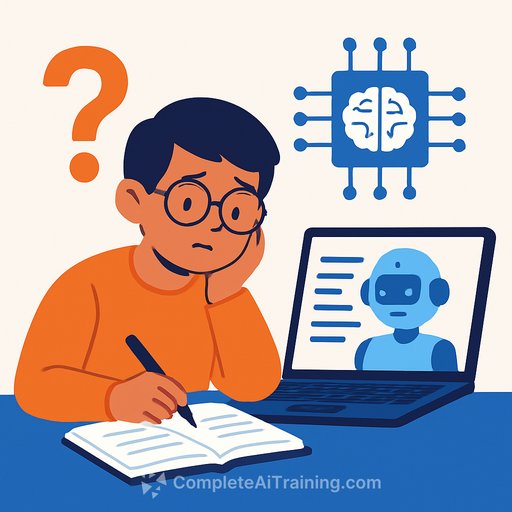AI in Higher Education: Helpful Assist or Hidden Cost?
Generative AI moved fast on campus. The open question for educators isn't "if" students will use it-it's how to guide that use without hollowing out learning.
From course notes to coding classes, AI is now embedded in daily academic work. The upside is speed. The downside is shallow thinking and weakened ownership.
When AI Replaces Teaching, Students Notice
At Northeastern University, student Ella Stapleton said she found AI-generated material inside the notes for an organizational behavior course-complete with a standard chatbot disclaimer. The content felt incoherent and hard to learn from.
"It was basically like just word vomit," she said. Stapleton lodged a complaint and even asked for a tuition refund for the class, arguing that students weren't getting what they paid for: clear instruction and real teaching.
Northeastern later said it embraces the responsible use of AI to support learning, not replace it. The refund didn't happen, but the moment highlights a bigger issue many campuses are facing: Where is the ethical line for AI in instruction?
Degrees, Certificates, and the Market Signal
Universities are moving quickly on AI programs. Rivier University in New Hampshire now offers a bachelor's in AI at just under $40,000 per year, touting a median salary in the field of roughly $145,000. Carnegie Mellon launched the first AI bachelor's in 2018, and master's programs across New England are growing.
Boston University also offers an "AI at BU" student certificate-a short, self-paced course that covers fundamentals, responsible use, and practical applications. The message is clear: AI literacy is table stakes.
Students feel it too. "Are you using AI in a productive way, or using it to cut corners?" said BU student Lauren McLeod. "If you don't use AI, you're gonna fall behind."
The Policy Gap
Planning is happening, but policies lag. In a 2024 EDUCAUSE survey, most higher-ed professionals said their AI planning is driven by student use. Yet only a fraction of colleges have published clear AI-use policies for courses.
That gap leaves instructors exposed and students confused. Clarity beats suspicion-and it protects academic standards.
What AI Might Be Doing to Thinking
Students are using AI for homework help and code-often daily. Some know it's changing how they learn. "I feel like it's definitely not helped me learn the code as easily," said BU student Kelsey Keate. "I take longer to learn code now."
Research is raising flags. An MIT Media Lab study of student essay writing found that AI convenience came with a cognitive cost: reduced engagement, weaker critical evaluation of AI outputs, and less ownership over the final work. Graders also spotted a familiar structure across AI-assisted essays.
One of the study's authors, Nataliya Kos'myna, urged more research on how AI affects cognition as it becomes routine in academic work. You can review the lab's work here: MIT Media Lab.
Practical Guardrails for Faculty
- Set explicit AI rules by assignment. Spell out what's allowed (idea generation, outlining, code hints) and what's not (draft writing, final code, citations).
- Require AI transparency. Ask students to submit prompts, outputs, and what they kept, edited, or rejected.
- Assess thinking, not just output. Use oral defenses, in-class writing, problem walkthroughs, and reflection memos.
- Design assignments AI struggles to fake. Personal data, local contexts, unique datasets, staged drafts with feedback, and evolving requirements.
- Build AI-free practice. Short, regular reps without tools to strengthen recall and mental models.
- Mix assessment formats. Proctored work, handwritten sections, and open-note questions that demand reasoning and evidence.
- Support faculty time. Redesigning courses, checking AI outputs, and giving better feedback requires workload adjustments and training.
Program and Policy Priorities for Academic Leaders
- Publish a university-wide AI policy framework with course-level flexibility.
- Stand up faculty training on prompt quality, verification, AI bias, and academic integrity.
- Establish quality checks for AI-generated instructional materials in LMS shells and slide decks.
- Create micro-credentials for students on responsible AI use and source evaluation.
- Track outcomes. Compare learning gains across AI-permitted and AI-restricted tasks; adjust based on data.
- Address equity. Provide access to approved tools or offer alternative pathways so lower-resource students aren't disadvantaged.
What Students Are Saying
Many students want guidance, not blanket bans. They see AI as a tool that can help-but they also admit it can dull effort if they lean on it too much.
The goal isn't to police curiosity. It's to teach judgment: when to use AI, when to turn it off, and how to verify its output.
If You're Building AI Capacity on Campus
- Start with a clear definition of "allowed uses" by discipline.
- Provide model assignments that integrate AI ethically.
- Add short, required modules on AI citation, bias, and verification.
- Offer students a simple decision tree: Ask, Generate, Critique, Verify, Cite.
Further Reading and Training
- Trends in student use and attitudes: Pew Research Center
- Practical AI learning paths for academic roles: Complete AI Training - Courses by Job
Bottom Line
AI can speed feedback and broaden access to examples, but it can also blunt critical thinking if it becomes the default. The fix isn't fear or unchecked use-it's structure.
Give faculty clear policies, give students practical rules, and design assessments that reward original thought. That's how AI helps learning instead of quietly replacing it.
Your membership also unlocks:






